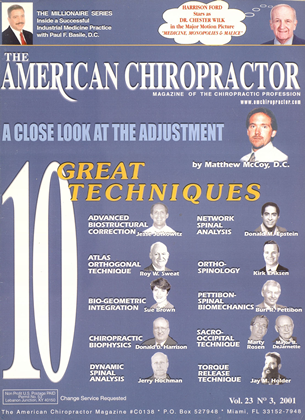It all started out like most new patient encounters. He called on the phone, complaining of low back pain : of about three weeks' duration. It seems that he had lifted a toolbox at ; work, one handed, and "pulled his low i back muscles on the right side." Over : the next three weeks, the pain was ! unrelenting, the spasms had been wors- ! ening; and, now, it had spread into his | buttocks and down into the upper pos- ! terior thigh on his right side. ! He had been seen in the emergency [ room—because that's where his super- i visor had sent him—where he had ; been briefly examined and, after a i period of time, had been X-rayed. He | had been given a two-day supply of I medications and had been told to use j heat packs (not unusual for the ER j visit of today). j After that brief visit in the emer- j gency room, he had been referred to j his "family physician" for follow-up '' care. That follow-up care consisted of the typical medical model of pain med- j ications and muscle relaxants. He had \ been sent to a physical therapist for | stretching and strengthening exercises, 1 since the medications had not worked j in the first week. His condition | seemed to be getting worse day by day and. to him, it felt that the more they did, the worse it got. So, he was look ing for a change. i His new approach was to seek out a ! chiropractor. He chose my office | because of a referral from a friend. It was just the start of another day. In our office, we performed the usual paperwork, requested his prior records, took his vital signs, measured his range of motion, deep tendon reflexes, and performed a palpation examination. I was certain that, since he was getting worse, they had missed something along the way. I was in diagnostic mode, not treatment plan mode, thank goodness. It was reported that the patient's X-rays were in order, but I decided to take a postural set to see what was going on. He was reluctant to get another set taken, but he agreed, after a brief explanation of what chiropractors look for on films. This was not to be just another day. I was about to learn a great lesson. The good news is that I was looking at these X-rays, expecting to see a problem that someone else had missed. The bad news is that 1 found one— actually over 30 such problems. They looked like an assortment of white ping-pong balls, lemons and even grapefruits, superimposed over the body in a fairly random pattern. At first glance, I could not believe that anyone else had missed this finding, so I tried to "write it off" as some bizarre processor error—until I looked a little harder. There it was, in all its tragic splendor: a full-blown case of Hodgkin"s lymphoma, in a severely advanced state. His musculoskeletal strain/strain subluxation complex continued to be an issue and, thus, we successfully helped with that condition. But our more immediate concern was this very serious disease. I made the referral and, two days later, his surgeon called to suggest that, without my prompt diagnosis, the patient would have been untreatable in less than two weeks. You see, he was in the middle of a fast growth period for his lymphoma, and it would have become inoperable. As it was, they removed over 30 lesions. We followed this patient for some time, and after a few years lost track of him. He was doing well, his back condition had been resolved and the results of his lymphoma treatment were to his satisfaction. Overall, a possible tragedy had been averted—or, at least, put off—so this young man could enjoy a few more productive years. As with most stories, this one has a moral. For me, the moral was, '"Don't be so certain what you are looking for, until you find it." The emergency room doctor and family physician had both been looking so hard for a musculoskeletal condition that they found one and found nothing else. For them, this turned into a professional liability nightmare and it could have been one for me, too; except that, I had been looking at those x-rays with a clear mind and no preconceived ideas. Another thing I learned through this experience is that having someone looking over your shoulder at your x-rays is a good thing. That "second look" can make all the difference between a professional liability nightmare and successful patient care. There are services which assist doctors : by giving a "second opinion" on their [ x-rays. When I treated this young, man such services were not available; ; today they are, and we should all be using them regularly. Our patients are ; counting on us to find the conditions that everyone else misses. It is true that two sets of eyes are better than one. Dr. Jim Warner is a practicing chiropractor with over 20 years of experience. A frequent contributor to The American Chiropractor, he teaches regularly at the Karl Parker seminars i and has programs available for state and regional associations on x-ray interpretation, adjusting technique and cost-effective chiropractic rehabilita^ tion. He can be reached at 503-390-1144. °
 View Full Issue
View Full Issue









